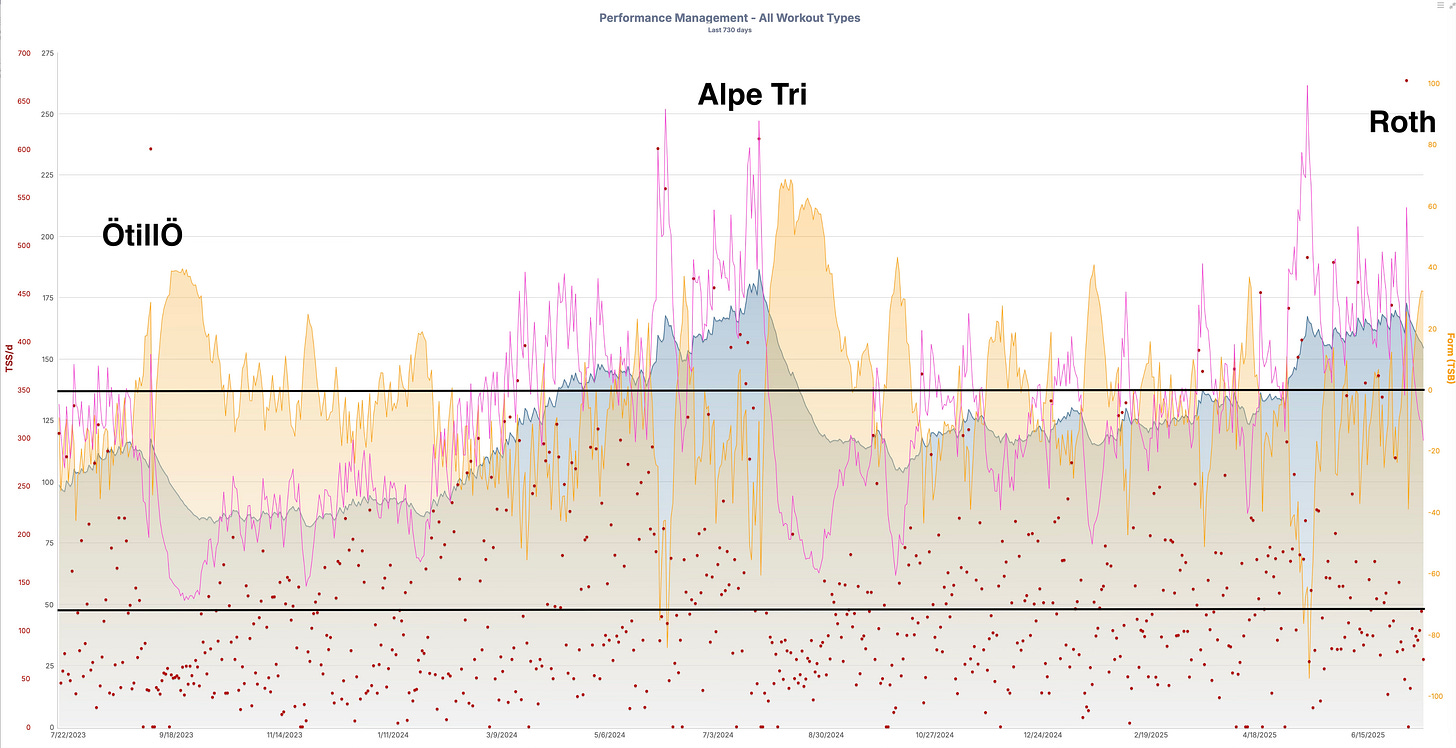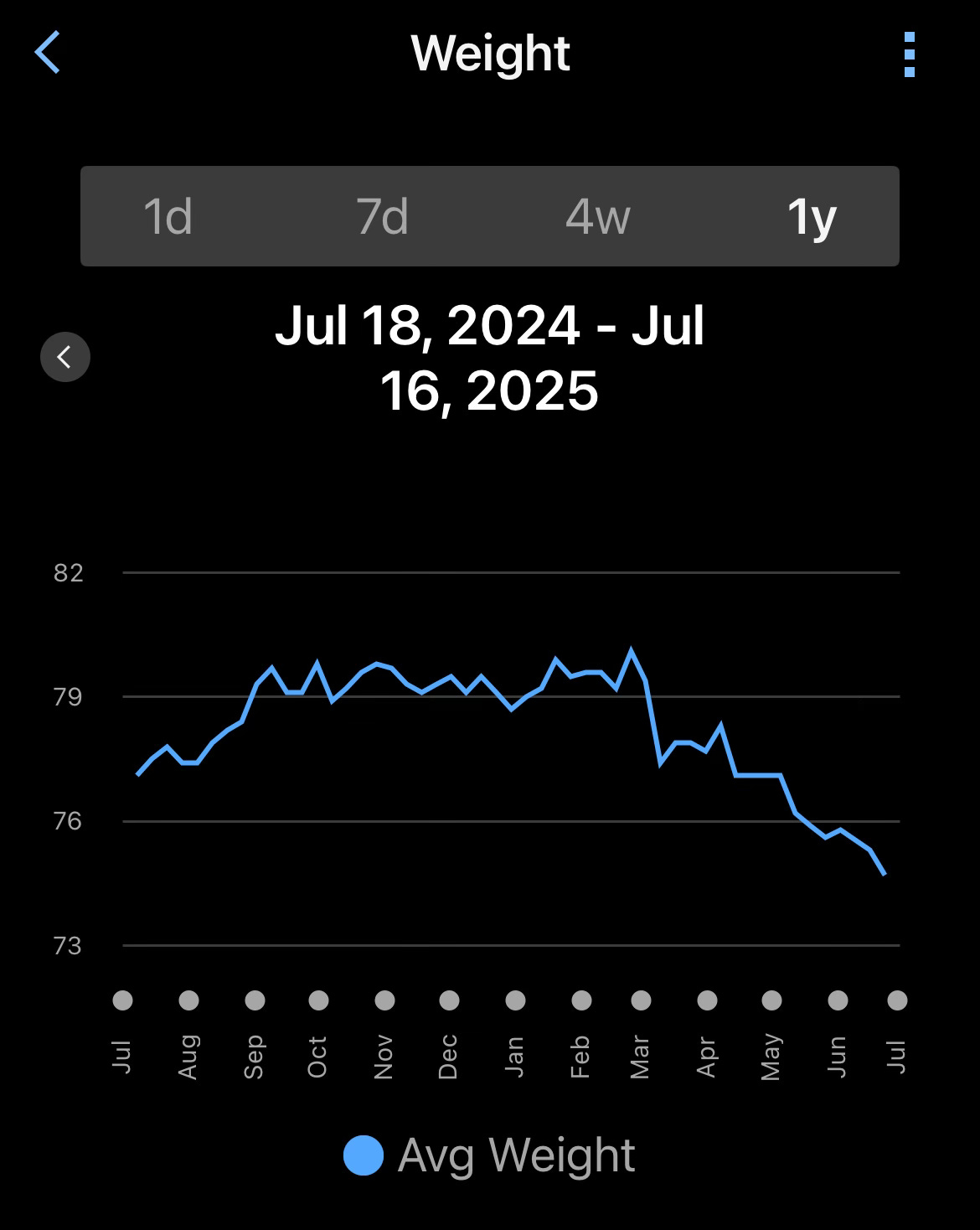Many errors are made because we fail to learn from our personal histories.
Coming off a successful season, I want to share tips you can apply immediately to improve your training response.
First, let’s recap the prime directive.
Compound adaptive volume is the primary driver of endurance gains.
When we are starting out, it doesn’t take much volume to knock us off our game.
It takes even less intensity to knock us off our game.
Because of volume’s central role in our program, we need to protect our ability to keep training.
With our eye on the central role of volume, we focus on adaptation.
Our task:
Enough stress to move the needle.
Then, adapt to the stress.
Repeat.
At the beginning, it will not take much stress to move the needle. For example, my easy ride (this summer) used to be a challenging endurance session (three years ago). The load (1,200 kJ - 166w for two hours) is the same. The stress experienced is vastly different.
Same Load, Same Body, Different Response.
As our fitness improves, several things happen:
The stress required to move the needle increases.
Our general capacity improves, enabling us to recover while training easy.
The benefit of low stress days increases.
All athletes struggle with the third point => the benefit of an easy day increases.
Think you need one easy day? Take two.
Think you need two easy weeks for an offseason? Take four.
When the compulsion to train is high, athletes will only experiment with these tips in extremis — mental breakdown, injury and illness. That’s a shame. Proactive recovery, when healthy, is more powerful.
Three years ago, I felt like I had nothing to lose. I was out of race shape and unsure of my ability to return to competition. Now that I’m in great race shape there is a temptation to believe I have much to lose. Fear of losing is a poor mindset to guide decision making.
A better way to frame the issue is to look backwards at what the athlete was able to achieve by being sensible. Document the personal history and make the lessons crystal clear.

If you expand the chart then you’ll see two years of periodization. Across the period, I went from a developmental athlete to top amateur.
Along the way, I made a couple surprising discoveries. Many thanks to the top coaches and physiologist who were generous with sharing their experience. This series is my way of synthesizing their philosophies, sharing opening and, hopefully, moving endurance sport forward.
My guiding principles:
High Volume - because of the central role of volume, we need to keep volume up. Up with respect to our individual competitive category, not our favorite Norwegian elite.
Low Mileage - run miles beat us up. The best athletes I know are frequently battling orthopedic issues. For a long career, stay below the breaking point.
Focused Acute Stress - loading must be enough to move the needle, without disrupting the accumulation of adaptive volume.1
Low Chronic Stress - half (or more) of our days are low stress. This reduces a range of problems, which reduce our capacity for chronic adaptive volume.
In the six weeks (42 days) leading up to Challenge Roth, only twelve of my days were high stress (12/42 = 30%). Ten from training, one from travel and one from life stress. An average of two high-stress days per week.
As an elite, I would have aimed for double that number. That approach pushed chronic stress too high, slowed adaptations and made many of my loading days survival sessions rather than positive experiences.
Two years ago, I thought my goal was to get to the point where I could handle four high-stress days per week. I was wrong.
Less Chronic Stress - More Focused Stress
Where I’ve ended up.
Move the needle.
Adapt.
Repeat.
As I became more fit, my move-the-needle workouts became substantial. I’ve shared examples in prior articles.
7.5 Hour Race Sim Day with 3:45 of bike time at 70.3 effort
Not only were these workouts impossible two years ago, performing any of them would have disrupted my capacity to accumulate adaptive volume. All of these workouts were done inside a background of uninterrupted 20-hour training weeks.
Expected & Unexpected Findings
No surprise that compound volume works.
What’s been surprising is the mechanism of improvement.
Each Season Sees A Faster Return To Peak Fitness: This year, a single high-volume month (103 training hours in May 2025) was enough to return my fitness to a level that took three months to achieve in the prior year (April to June 2024).
Have faith you will return to a similar level you achieved in the past.
Use this faith to make smarter decisions in the present.2
Increasing Baseline Tolerance: For each of the last three winters, I have tolerated a higher baseline level of load. I see this as a reflection of improving General Capacity.
Baseline tolerance rising isn’t surprising - fitter athletes can do more. My strategy for last winter was Fill In The Gaps.
The next one was completely unexpected.
Higher Acute Stress, Less Chronic Stress : Big surprise that the game is not cramming more high-stress days into my program.3
If you are an elite then you should apply this finding into your program. I see my peers stressing themselves nearly every day, over racing, scheduling unnecessary travel… all while trying to stay extremely lean. There’s a better way available.
Despite being haunted by not-doing-enough feelings, my ample low-stress days work better.
Notice, then document, what works:
Increased tolerance for compound adaptive volume.
Faster race performance than my expectations.
Faster race performance than my peers.
Less stress on my family life.
Increased enjoyment from sport.
The challenging part is creating space.
Time — Stress — Stability
Space has different components:
The time to do the training.
No getting around the need for volume.
The time to do everything around the training.
A simple life structure.
A low-stress environment.
Quiet life, stable relationships.
Stability in work, family, nutrition and emotional state.
All of the above, combined with an emotional capacity to keep the low-stress days low stress. Simple, not easy. I am constantly holding back and that spills over into my racing.
Downstream Implications
When loading-adaptation is on target, there are positive downstream effects. A more positive attitude improves our sleep, mood and nutritional choices.

Lower chronic stress sets up a positively reinforcing cycle of stress-adaptation-repeat.
Stepping outside of athletics, we find our relationships run more smoothly, there’s less drama in our lives and the quality of our decision making improves.
I included the weight chart (above) to make two further points to my peers. I have proven it is straightforward to manage my weight. I didn’t need to starve myself and I raced well.
For you…
During illness/injury, continue to eat, stay energy positive and heal the body. Many competitive athletes constrain nutrition when training volume goes down, as well as on their easy days.
Every year includes long anabolic phases. These phases are the Endurance & Strength blocks explained earlier in this series.
It is unsustainable to seek race-shape from February to November. If you can’t see it in yourself then look around at your peers and competitors.
Be smarter, win big races, break records.
I pulled this article’s key points into the video below.
Where To From Here?
My hope is you’ll get more enjoyment from your training. Endurance sport is a wonderful way to live.
I hear my speedy pals talk about how well these methods work… then watch them get sucked back into the compulsion to train.
Using this approach, I still get sick, make mistakes and have to manage niggles. The difference is my setbacks remain small, my enjoyment is higher and I’m not chronically wigged out.
Seeing as some of y’all are going to be reluctant to accept my findings… I will continue to improve (and publish) to the point where you have to pay attention to me. 😉
With that in mind, I have a four-year plan to execute that I’ll explain in a future article.
Back to The Physics of Performance
Back to Endurance Essentials eBook Page
Loading for each day, and block, follows the Block Periodization approach explained in this series. Access the full series here. Be sure to read the section on Dynamic Loading in Chapter Ten.
My deep off seasons and ample low stress days have cost me nothing. They are an important part of my body’s ability to benefit from my ramp each summer.
Thank you to Stephen Seiler for making the point to polarize stress, not load, volume or intensity. See the Real Science of Sport Podcast with him. I listened to that conversation just before my race specific build for Roth. It gave me the nudge I needed.



First class write up✅
Thanks for sharing. Massive inspiration
FWIW your advice does rub off 😉
Keep small setbacks small IYKYK 😂
Hi Gordo, great info as always! I queried Chatgpt today with the following: My current (hybrid) training is 2 days a week serious max strength, 4 days x 2hrs bike. One of those days with intervals, 3 around LT1- One rest day a week. I was wondering if it might be a better choice (I'm 57) to do 2 x 2hrs and 1 x 4 hours, with an extra rest day. So same volume, different distribution. I was thinking the 4 hour ride might elicit quite different adaptations to the 2 hour rides. What do you think? I know you have written often about very regular work being the first thing to get on top of....